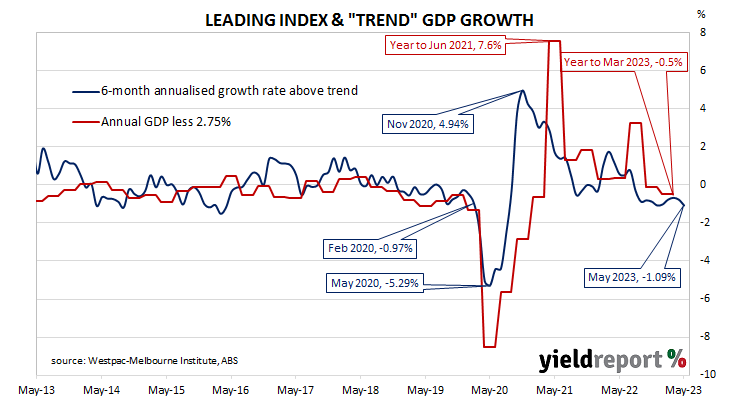Summary: Leading index growth rate falls in May; lowest reading since pandemic; reading implies annual GDP growth of around 1.75%; ACGB yields fall; rate-rise expectations firm slightly for third quarter, ease for subsequent quarters; Westpac lowers growth forecasts, GDP growth of 0.6%, 1.0% in 2023, 2024.
Westpac and the Melbourne Institute describe their Leading Index as a composite measure which attempts to estimate the likely pace of Australian economic growth in the short-term. After reaching a peak in early 2018, the index trended lower through 2018 and 2019 before plunging to recessionary levels in the second quarter of 2020. Subsequent readings spiked towards the end of 2020 but then trended lower through 2021, 2022 and the first half of 2023.
The May reading of the six month annualised growth rate of the indicator registered -1.09%, down from April’s figure of -0.78%.
“This is the lowest read of the growth rate of the Leading Index since the pandemic,” said Westpac Chief Economist Bill Evans. “It continues the run of negative growth rates which began last August and is entirely consistent with the disappointing growth rates which have been reported for the December and March quarters.”
Index figures represent rates relative to “trend” GDP growth, which is generally thought to be around 2.75% per annum in Australia. The index is said to lead GDP by “three to nine months into the future” but the highest correlation between the index and actual GDP figures occurs with a three-month lead. The current reading thus represents an annual GDP growth rate of around 1.75% in the next quarter.
Domestic Treasury bond yields fell on the day but lagged the falls of US Treasury bonds yields overnight. By the close of business the 3-year ACGB yield had lost 4bps to 3.89% while 10-year and 20-year yields both finished 5bps lower at 3.98% and 4.23% respectively.
In the cash futures market, expectations regarding further rate rises in the third quarter of 2023 firmed slightly while expectations regarding rises in subsequent quarter eased a little. At the end of the day, contracts implied the cash rate would rise from the current rate of 4.07% to average 4.16% in July and then to 4.32% in August. February 2024 contracts implied a 4.48% average cash rate while May 2024 contracts implied 4.39%, 32bps more than the current rate.
Evans noted Westpac had recently downgraded its GDP growth forecasts, expecting 0.6% growth and 1.0% growth for calendar years 2023 and 2024 respectively. These forecasts are now noticeably below the RBA’s latest figures of 1.25% and 1.75% for 2023 and 2024 respectively.


